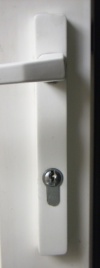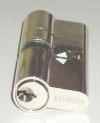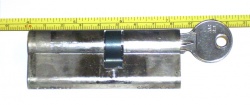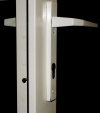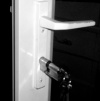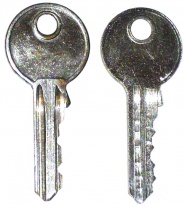Replace a eurolock cylinder
Eurolocks are a modern pattern of cylinder deadlock. As well as key operation, thumbturn cylinders are available, mainly for bathrooms, bedrooms & cupboards.
Replacing a eurolock key cylinder is very easy, you just need to get the right length of cylinder to suit the door thickness. The lock cylinder can be replaced on its own, without removing the lock itself.
There are also other incompatible cylinder lock systems in use, such as Replace a lock cylinder.
How easy
Replacing the key cylinder is a very simple job, as long as you can open the door. The lock isn't replaced, only the cylinder.
Why replace
Apart from the obvious...
A new cylinder is around £5 for a basic one, or £20 for one with 6 hardened pins in 2011. So replacement is sometimes cheaper than copying keys. New cylinders usually come with 3 keys.
When moving into a house, you've no idea who has keys. Its prudent to replace external cylinders.
Some house insurance policies are only valid when a specified type of cylinder is used on an external door. Such policies typically require a cylinder with 6 hardened pins. (There are often requirements for the lock too, such as either meeting EN or being a multipoint lock.)
The new cylinder
The main choice with new cylinders is what length you need. The pictured one is called 45-35 (or sometimes 40-10-30). The replacement cylinder does need to be the right size, cylinders that stick out are rather vulnerable to known attack strategies. And obviously a 35-55 couldn't be replaced with a 45-45. If the old cylinder is missing, each of the 2 length figures is the distance in mm from the retaining screw to the outer face.
Then you can have brass or chrome finish, hardened pins or not, 5 or 6 pins, and key operated or thumbturn.
- Cheaper unhardened pin cylinders are easier to drill open
- house insurance often requires 6 pin hardened on external doors
- unhardened is usually preferable for interior use, easier to remove if keys are ever lost.
You can also get cylinders with restricted key profiles. Keys can then only be copied by authorised dealers, once a certificate of ownership has been produced. (Legal position on this.)
You can also get keyed alike cylinders, and cylinders with master & submaster keying etc. Locksmiths can make these up.
Eurolocks have been opened by burglars by snapping & bumping. Snap & bump proof cylinders are available, like the Avocet ABS.
Its best not to have new locks, cylinders or keys posted to you. The seller usually has your address, either from the delivery address or credit card details, and there are people that copy keys and misuse them.
Used cylinders are just as secure as new, if the seller doesn't know where you live.
- If it doesn't come with 3 keys, bear in mind the cost of copies
- The picture (right) shows the number of pins in each lock
- The number of pin landings on the key also reveals whether its 5 or 6 pin - but its easy to miscount them
How to replace
Replacement is simple:
- Open the door
- remove the retaining screw
- Turning the key about 30 degrees in the right direction enables the cylinder to slide right out.
- Insert key in new cylinder, turn it, and slide the cylinder into place. (If it catches, waggle it. If it still catches, loosen the handle screws a little temporarily.)
- Replace the retaining screw
Issues
Issues sometimes encountered:
Gain access
If you're locked out and can't get in any other way, you can drill the lock cylinder, or if there are no protection plates fitted, snap it in two. If drilling, expect to ruin a few drill bits in the process.
Lock needs to accept old key
In some situations you might need a new lock that takes the old key. Rekeying a lock cylinder is a locksmith job.
Stiffness
The usual cause is a door that isn't correctly aligned with the frame, resulting in a multilocking mechanism that isn't engaging 100%, thus the lock refuses to engage readily. Less often, overtightening the retaining screw can also cause stiff operation.
Oiling the cylinder is never the solution. It causes staining of hands & clothing with dirty oil, and gradual accumulation of muck inside the lock that hinders functioning.
Key needs waggling
If the key needs waggling to be able to turn, this is caused by a poorly cut key copy. It can also happen on old lock cylinders that have had a lot of use, and the mechanism is well worn.
Key doesn't insert smoothly
The key needs waggling to insert, or is stiff to insert. Some keys have a series of raised points between the pin landing areas as a result of the way they're cut. This can cause keys to not go in smoothly. The solution is to file these raised points on the key down - obviously the pin landing areas must not be filed down.
The key on the right has these projections, the left one doesn't. The 5 flat low points between the projections in the right key are the pin landing areas.
Key doesn't turn
If a key just doesn't turn at all, its not uncommon for a copied key to fail to work, due to a slight error in cutting.
